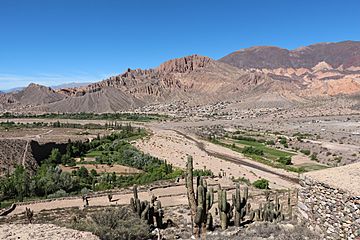Quebrada de Humahuaca facts for kids
| UNESCO World Heritage Site | |
|---|---|

View of the Quebrada db Humahuaca
|
|
| Location | Jujuy Province, Argentina |
| Criteria | Cultural: (ii), (iv), (v) |
| Inscription | 2003 (27th Session) |
| Area | 172,116.4375 ha (425,308.979 acres) |
| Buffer zone | 369,648.8125 ha (913,422.108 acres) |
The Quebrada de Humahuaca is a long, narrow mountain valley in Jujuy Province, northwest Argentina. It's about 155 kilometers (96 miles) long. This special valley is surrounded by high plains (the Altiplano) to the west and north, hills to the east, and warmer valleys to the south. It's located about 1649 kilometers (1025 miles) north of Buenos Aires.
Contents
What is a Quebrada?
The word quebrada means "broken" in Spanish. It describes a deep valley or a ravine. This valley gets its name from Humahuaca, a small city with about 11,000 people. The Grande River flows through the Quebrada. It's usually dry in winter but fills up with water during the summer.
A Place Through Time
The Quebrada de Humahuaca has always been an important pathway for people, trade, and cultures. People have lived here for at least 10,000 years. The first people were hunter-gatherers, and we can still find many old remains from them.
Ancient Farming
You can see many stone-walled farming terraces throughout the valley. These terraces are thought to be more than 1500 years old. People still use them today! These farming areas are connected to old fortified towns called pucaras.
Important Roadway
Later, in the 15th century, the valley became a main road for the Inca Empire. It was also a key link between different parts of the Spanish colonies, like the Viceroyalty of the Río de la Plata and the Viceroyalty of Peru. Many battles of the Spanish War of Independence also happened here.
A World Heritage Site
Because of its long history and unique landscape, the Quebrada de Humahuaca was named a protected landscape in 2000. On July 2, 2003, UNESCO made it a World Heritage Site. This means it's a very important place that needs to be protected for everyone to enjoy.
See also
 In Spanish: Quebrada de Humahuaca para niños
In Spanish: Quebrada de Humahuaca para niños




